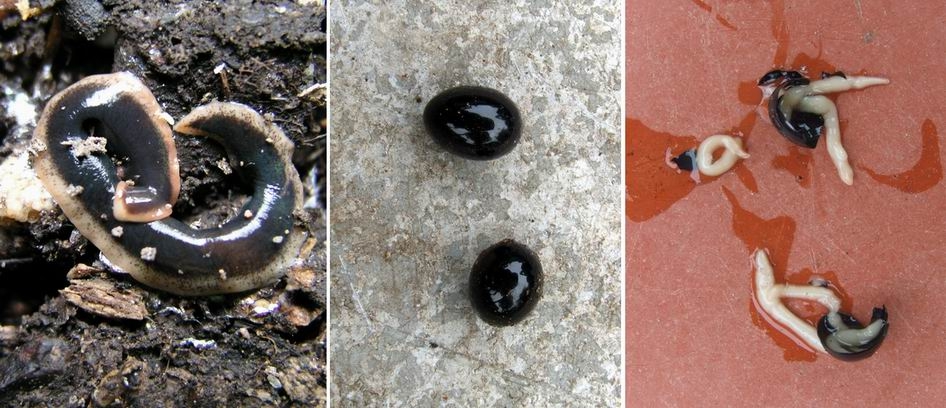
Ludwig Appeltans has included a circular economy into the design for the nature-based permaculture community he created on the Isle of Skye. If you want to hire him or learn from him, please feel free to join the Virtual Village.
New Zealand and Australian Flatworm
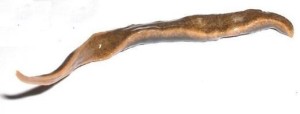
The New Zealand flatworm (Arthurdendyus triangulatus) was first noted in the western parts of Scotland in the early 1960s. Flatworms have now been identified throughout Scotland.
In its native New Zealand, the flatworm is found in shady, wooded areas and only on the cooler South Island. Flatworms were probably introduced into the UK in the soil in pot plants sent or brought from New Zealand.
The flatworm has taken hold in a lot of gardens and garden centres without people realising it. After they have decimated the earthworms and therefore their food source, flatworms shrink to a tiny size and lay dormant, so eventually people might notice that they don’t have a lot of earthworms, but don’t know why.
Description
When resting, flatworms will be coiled and covered in mucus. They are very distinctive and look nothing like earthworms. The upper surface is dark, purplish brown with a narrow, pale buff edge.
The underside is also pale buff. They are pointed at both ends, and ribbon-flat. A mature flatworm at rest is about 1cm wide and 6cm long. When extended, it can be up to 30cm long, and proportionally narrower. Flatworm ‘eggs’ or capsules are shiny black, just under 1cm long, and like a misshapen blackcurrant. They contain as few as two, or as many as eleven young worms.
The worms seem to be simple ancient life forms that have survived for tens of thousands of years in a little pocket on a small island. They have no internal organs: digestion is done outside the body and interned by osmosis through the skin.
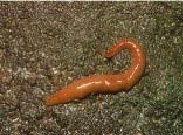
Several other species of flatworm have been found in the UK since the introduction of A. triangulata. They are the same shape as the common form, but come in different colours, the orangey-red Australian Flatworm (Australoplana sanguinea var alba) which is common in England, or the creamy white Edinburgh Flatworm (Arthurdendyus albidus) only known from Edinburgh.
WARNING: Some people find flatworm mucus irritant, so wear gloves if handling them.
Life Cycle
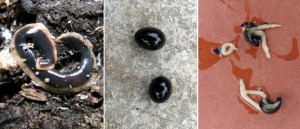
Adult flatworms produce egg capsules in summer. A capsule can be between 4-11mm long and 3-8mm wide, and resemble a blackcurrant. Juvenile flatworms emerge after about a month and are creamy white/pink in colour.
Feeding Habits
Flatworms seem to eat earthworms exclusively. There is no evidence that they will eat any other soil-dwelling creatures, even when the earthworm population has been reduced to below detectable levels. There is no apparent preference for one particular worm species. Flatworms are most active near the soil surface, so deeper burrowing earthworms are more likely to survive despite the presence of flatworms.
When an earthworm is located, the flatworm covers it with digestive juices. This dissolves the earthworm, which is then sucked up by the predator. Estimates suggest that flatworms will consume one or two earthworms per week. When its food supply has been virtually exhausted, a flatworm will shrink and wait until there are sufficient earthworms for feeding to restart. This waiting time can be as long as 12-24 months. It is not yet clear whether flatworms will move long distances to alternative feeding sites.
What’s the Cure?
There is none! Once it is in your garden, it is there to stay.
Prevention is the Only Method of Control
Seeds, cuttings and clean bare-rooted plants are safe. Soil and manure needs to be inspected really carefully. Best NOT to buy plants in soil from nurseries and do NOT accept soil in any shape from well-meaning friends. One egg the size of a black current is enough to infect your garden.
The best way to get new plants in your garden is to import them with seed or cuttings. Or at least bare rooted. That also helps prevent importing other pests and diseases. This is becoming more and more important.
An infected garden is bad, but not the end of the world.
It is possible to live with the flatworm and help the earth worm population recover by continuously capturing the flatworms and setting up an earthworm farm on stilts. Flatworms like to rest underneath plastic bags that keep the soil moist and dark.
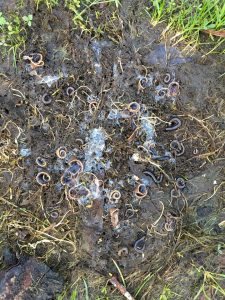
Best way to kill them is to use a jam jar with salt to contain and kill them.
Ground beetles seem to attack smaller worms. Providing a safe habitat for those beetles help a little. (see Dealing with Slugs in a Permaculture Garden) Mulching and adding lots of organic matter to your garden is something you do in a permaculture garden anyway, but it helps to keep the soil healthy with less earthworms doing the digging for you.
Several natural enemies are known from New Zealand. However, little is known about their biology and they are unlikely to be specific to the one species of flatworm. As a result, it could be difficult to find good biological control agents that attack only the target flatworms.
There is some anecdotal reports from people that the earth worms and flatworms eventually coexist in some sort of balance.
Dangerous Myths:
- Immersing them in warm water (+34°C) for ten minutes might kill the worms, but not the eggs.
- Immersing the soil of plants in water for 24 hours will bring the mature worms to the surface, but again, not the eggs.
- Plants from nurseries are safe.
- My plants are safe, I have never seen any Flatworm in my garden.
Ludwig Appeltans has included a circular economy into the design for the nature-based permaculture community he created on the Isle of Skye. If you want to hire him or learn from him, please feel free to join the Virtual Village.
Pictures and info: CC licence

What happened to research into biological control? Hadn’t a parasitic midge from Tasmania been identified as a possibility?
I have a very high frog population, my flatworms seem to have gone, earthworms back in force, any info on whether frogs will eat them?
Regards frogs, yes I spoke to a person who says he actually saw a frog eat a big flat worm- and why not, they do eat slugs.So keep the frog population strong. And just like grey squirrel is an invasive pest, there is now evidence to show where there are Pine Martens the greys disappear and the reds make a come back.
Just found some in my new garden. Will be interested in any developments on control. Frogs sound good!
Hi Paul, it seems that the possibility of introducing new pests has been abandoned as a bad idea as we do not know the effects those predators will have on other wild life. The cane toad in Australia is a classic example.
Eileen, I have not found any information on this. I have heard about ground beetles, not about frogs.
Well, 9 months later still very few flatworms (9 so far this year), lots of frogs,
and big happy earthworms. All I did was go out every night with a flashlight to collect them. At one stage was getting 60 a night.That was 2013, so do not give up hope.
Hello,
How are your flatworm and worm population now? I also go out most evenings at the moment in June only one or two but come the winter i am expecting loads
Thank you
I have noticed that their population goes down in warm summers such as in 2014 and also they seem to leave compost bins and manure areas which have got hot which enables earthworms to recover numbers.
That makes sense as their distribution seems to indicate a dislike of warmer climates.
Some literature I’ve read does say they will follow the big deep burrowing worms down into their burrows and devour them though I don’t know that from personal experience.
I have noticed chickens eat them enthusiastically as well but suppose they would need to be nocturnal (like kiwis) to be very effective.
Looking at the distribution around Forres it seems that unless assisted by humans moving soil and plants they can take a long time to get across roads and my garden is still free though 200 yards away they have been rampant for sveral years now though I read they can be moved around on cat fur and even boots.
I do wish that people would take the problem more seriously as flatworms seem to have lots of friends exchanging potted plants and soil with little regard for the consequances.
Apologies for posting on an old thread but this mild winter has resulted in a huge explosion of Australian flatworms here. I’ve studied them for 15 yrs including running a project and local survey when I was at horticulture college but I have never seen anything like we’ve got this year. For the last few nights, every path and the bottom of every wall in our garden has scores of them. They’re evident on the roads around our house in evening and early morning and they do travel at quite a pace relative to their size.
Over the years I’ve tried and monitored numerous controls – hens (ours preferred to eat the earthworms), frogs and newts (loads of them in ours and neighbouring gardens, no noticeable difference), hedgehogs (thriving population here, they don’t touch flatworms), trapping and ‘squishing’ (works as long as you don’t want any other sort of life and don’t mind getting obsessed), beetles (I have seen ground beetle larvae eating them but we’d need thousands of beetles to be an effective control). Birds don’t take them. The best control is the one I can’t influence – weather! Cold winters and the odd hot summer have decimated numbers of live flatworms but as the article says, the eggs are tough, really tough and almost impossible to spot. We’re on a very light sandy soil which also means they can ‘burrow’ – I’ve found live flatworms 30cm below the surface so presumably the eggs will be down there too.
When I did my study I realised the effect of the predator/prey cycle and the capacity of flatworms to shrink, retreat and wait for earthworm numbers to recover. Last year I noted more earthworms than we’d had for a few years so this mild, wet winter coupled with a food glut has resulted in a flatworm population explosion.
Some years we don’t see an earthworm at all but we still garden, we’ve had to go back to digging to get organic matter into our light, hungry soil but we still grow and get good crops.
Jill, thanks for this posting – really interesting. I, also have noticed a huge increase over the past 2 months on one of my allotments – up to 500. I would be interested in any information you have to share as I am keen to have a better knowledge of them.
thanks for info. i am horrified to have them here and am keen to fight back.
Hi Jill,
Thank you very much for your information as well! I have also been desperately looking for a solution to the Australian flatworm. I only just became aware of the problem. They seem to be on the surface of leave mould and bare tracks. Easy to spot with a torch. For now I just collect and seal them in a large plastic tub with a very tight lid. I wish there was some form of biological control. I have free ranging Guinea fowl since the end of last September. They eat everything and anything all day long. Maybe they will have an impact on the flatworm population.
There must be a solution.
Another question on invasive species for you: have you ever come across false black widow spiders? What would eat them and how to deal with an invasion of those?
Kind Regards, Martina
Oh Gosh this is not good news that they can shrink and wait for earthworm population to recover interesting though if anyone finds something to eat them please share do badger eat them?
Hi, I am in Lancashire and spotted the Australian version in my garden at the back end of last year. I found three or four and dealt with them after I saw them devouring an earthworm – not a pretty sight. However, earlier this month when constructing some compost bins, I noticed an awful lot more residing under the flags on which the compost bins will be. It would appear that we have been well and truly infected. This new site is quite a distance from the original sighting.
It is interesting because we have recently had the garden re-designed to cater for my disabled wife and allow her access all round the garden. This meant quite a bit of topsoil and a huge number of plants coming in and this may well have been the cause.
The real question is what can be done, if anything, or do we just let them get on with things and hope the earthworm population can survive the onslaught? Is the effort of a nightly patrol really going to make much difference? I will certainly be going out on the odd occasion to see if I can spot any but every night may be a little much:-) I didn’t realise, till I read these posts, that they came out to play at night!
So can anyone tell me how to improve my soil. It’s getting flooded as there is no aeration by the earthworms. I started a compost, but now realise the worms are not going to help make it good. I wonder if lime has any effect on these beasts? Has anyone tried putting lime on the soil. Or Jeyes Fluid, doesn’t that sterilise soil?
I’ve heard that salt can kill them, but too much of that could harm the soil I would have thought. I’ve only just moved to this new garden and I want to make a cottage garden. I’m feeling a bit defeated now.
Don’t worry. I have NO earth worms, thanks to NZ flatworm, but it doesn’t seem to affect my cottage garden. The compost heaps are full of little red worms doing their job, and the soil is good- just keep mulching wth compost, good leaf mould and manure .
Best of luck- nature is amazing.
question-do flat worms eat dendrobaena worms in my compost heap (bin) james
Hello, all! I’ve just found my first flatworm on the garden path under an old compost bag – now in a jar or salt :o( . Can I leave a submerged recepticle to catch some? Or should I leave the old compost bag out and check it regularly? My garden has few beds to dig and check and I have been doing work in the nursery school garden so I won’t be able to check that regularly (especially at night). Thanks in advance for any advice. :o)
Seems hedgehogs like them too as i found one under a compost bag whilst looking for food for a wee hedgehog that was wandering about in daytime.There was no hesitation gobbled it straight down.It would however explain why i couldn’t find any earthworms in the compost heap.
Lovely jubbly…. Our new garden has these flatworms- they’re a very pasty-pink colour and when coiled have a wavy edge which is quite paler. They are quite long when stretched out- more than a couple of inches. We did find some here last year.They were really quite big. They may have been here for ”ages”- the back garden is quite boggy in the winter. I didn’t ever see one of these creatures until we moved house. I am in Kilmarnock by the way.
I have them too, found them in 2021, found a slightly different solution as a lot of what is written is quite vague. The big way to solve is to realise they are nocturnal and like the cold. I first was looking under pots and using the salt method. Then after reading I went out one night with a torch and they were EVERYWHERE. I would boil a kettle, and go out three or four times a night with a torch, and pour boiling water straight on, it seems to kill them but has to be boiling as they are tough blighters. The reason I had to keep going out was as the worms started to recover I would find them coming under the fence. I was relentless for abut six weeks and will do the same this year. I still have them, but I also have earthworms again, my compost is composting again. But I must have been taking out a thousand a night for some weeks.
Thank you Claire for sharing your experience. That is valuable information to add to the page. We hunt for slugs at night, I have rarely seen any. I will be paying attention from now onwards though!
Boiling water seems like a scary way to move about in the dark. I would perhaps recommend a different way to kill them.
Just to add, when we moved to our current place 4 years ago there were very few earthworms and then found lots of flatworms. 4 years later, having dug a large pond, got hens, have hedgehogs wandering around the garden, and improved the soil with composting a lot, the situation seems a lot better and finding a lot of earthworms. Not sure which has helped the most, but suspect the hens – one is a very busy lady turning over leaves etc…
So, hope is out there!
Hi,
So my lawn is infested with flatworms, not sure what type. They’re black on top, brown under, and I’ve seen them eat earthworms a well.
I’ve been going out every night for the past week, with a spray bottle with white vinegar, just spray them and they’ll pretty much dissolve in 20 minutes, or they’ll just dry up and die.
This is easier than picking them up into a container if there’s a lot. It will hurt the grass, but I find it much easier.
If there’s a way to mass-eliminate these worms, let me know!
8 years on from my first post, still have the Australian Flatworms. The frog population has not been very good lately, due I think to them laying spawn too early, I do have free range chickens as well, they eat them but I am concerned that any eggs would survive going through their stomachs.
I have found and killed 286 this year which is a lot less than other years. I do have more large worms than when I first noticed them, my attitude is each one I kill is a worm saved. I notice that areas where I have found and killed large numbers seem relatively free of them next year, so I am making an impact.
On balmy damp nights I have seen them mating and hanging around in groups of up to five . Reading this back I sound slightly deranged, but I hate to find dissolved worms on the path in the mornings.
Look for them at the base of walls, they like to live in cracks between crazy paving, and at path edges.
I drop them into a jar of salty water, I was sprinkling salt on them then realised my chickens were eating the salty corpses.
My garden seems fine,and I now appreciate any worms I find.
Thank you for your update so many years later. It’s really helpful to hear your findings and stories.
not good news that they can shrink and wait for earthworm population to recover interesting though if anyone finds something to eat them please share! do badger eat them?
not good news that they can shrink and wait for earthworm population to recover interesting though if anyone finds something to eat them please share! do badger eat them? I also noticed less snails and empty shells I used to have a lot and hedgehog and badger.No badger for coupe years I thought it was access issue now am not sure.Hedgehog fat and still around so fingers crossed hes helping me control
Thanks very much to everyone who has commented previously. I’ve never found as much useful information on flatworms before.
I have an allotment in Edinburgh on a site where I was advised several years ago that there were flatworms present, but had never recognised one or had experiences like many of those reported by others. The soil on the plot is well nourished and productive and we do see earthworms, sometimes quite large ones, although perhaps not as many as we might expect.
What interested me here was the photo in the article from Jessica Kate Watts in Mayo. Although I have never seen the big flatworms, I quite often see little dark curled up things in the soil, with a banded appearance, rather like some of the ones in her photo. These are not flat at all, maybe 1-2cm long and 1-2mm across if they were stretched out. Are these the ‘dormant’ phase of the flatworm lifecycle? It would be difficult to get rid of all of them at that stage, but it would at least be useful to recognise them.
If that’s what these things are, it would confirm that’s it’s possible to live with them, even if you have to do more work yourself to keep the soil good.
I believe the banded insects you are seeing are millipedes. We have lots in our garden. I think millipedes are what’s in the picture on this page so I reckon that’s what you’re seeing too.
I live in Dublin and have had both types of flatworms in my garden for a number of years, but at least in some areas of the garden e.g. where there is a collection of potted plants in a corner of my back yard, I am finding lovely big earthworms and sometimes a couple of Australian flatworms close by. It gives me great pleasure to drop these revolting little horrors into a jar of boiling hot water. Ugh! But what I have been wondering is if perhaps centipedes eat flatworms? There seem to be an increasing number of these in the garden, but maybe that’s just wishful thinking on my part. It seems surprising that there hasn’t been more solid research into potential biological control of these flatworms, considering the serious impact they can have on vital native earthworms that are essential for healthy soils etc. Has anyone heard of any such research?
There is anecdotal evidence that centipedes and ground beetles may eat eggs or freshly hatched flatworms. It would be good to do an experiment indeed with native predators!
June 16th, 2023.
Hello flatworm fans!
Have found and destroyed 1925 this year, numbers reduced as the weather got warmer, and now only finding the odd one under pots or plastic.
As mentioned before, in areas close to the house where I concentrated the search last year the numbers dropped dramatically. Again in the spring I was finding groups of up to five or six together. My earthworms are doing well at the moment, I have unwrapped the flatworms from earthworms after they have been attacked but unless it has only just started the earthworm dies afterwards, presumably the dissolving has begun already.
I have never seen small ground beetles eating flatworms, but have seen them munching on earthworms that have been attacked by flatworms. They could be eating the eggs as I find it very difficult to find or recognise these. I have a lot of these small black ground beetles in the garden, and encourage beetles in general by leaving rotten wood in small areas. Frogs have not done well again this year, they spawned much too early and I have a lot of newts in the pond.
Flatworm control has become a part of life for me, and like other contributors to this I am amazed that so little is mentioned about them in gardening and wildlife programmes. Is anyone doing any serious research and if so can we get access to it?
Thank you Eileen, that is really helpful information.
I am not aware of any serious research being done regarding flatworms. I hope there are scientists doing that. If I hear anything, I will let you know and share it on here.
Indeed, I learned that the ground beetles (and centipedes) eat the eggs. The need places to hide under. Rotting wood for sure is very helpful.
Agree can’t believe there is so little about this I have recently become a victim or my poor earthworms have I was part of a plant sharing group on fb…i just didnt know the risks feel so guilty sad. maybe could lobby for serious research to be done…No one serms to know if badgers eat them some say hedgehogs will just need something to kill them rathee than me! Least I have found you guys and am learning more…
Thanks so much for all the info. I found my first flat worm five years ago, another two yrs ago and 5 so far this year here in Galway. I didnt know what they were so I sent photos and an email to the Dept of Agriculture and heard nothing back. Anyway I killed and disposed of them this year I flushed them down the toilet, now I am worried they might survive in a septic tank. Does anyone have any ideas on that. I will use jar of Salt & vinegar from now on and do night time searches when I do my snail & slug hunt. Hope research is being done.
Hello
We spotted australian flatworms in our Manchester garden for the first time this May, while out late at night searching for slugs. It requires hard work and vigilance to keep the numbers low. We’ve found the easiest way to kill them is vinegar. We search at night with a plastic tub of vinegar and a pair of tweezers, just drop them in they’re dead in seconds. I was hoping the winter weather might reduce numbers but from the comments above it sounds like they prefer the cold.
Hello everyone and wow – what a brilliant thread! Great insights, and also though I wouldn’t wish these things on anyone it is helpful to read all your flatworm tales! I’ve been gardening in my infested Devonshire garden for about 7 years now, and I’m always on the look-out for any information or intel that might help me in my endless battle with these creatures. I’m sorry to have to kill them, but when faced with what they do to earthworms there is no choice eh. I go out with my headtorch most nights twice, sometimes more, and in my very small garden got 112 Australian flatworms just in January. I use big tweezers to grab them, and put them onto a piece of newspaper. They then go into the fire. It’s very quick.
One thing I wonder about it how to help an earthworm that has been attacked. As has been mentioned, they can seem unscathed (depending on when you find them), and I always want to rinse the worm with something, because the flatworm’s digestive juices are still going to be on the worm, I would think. Rainwater is what I always have to hand, but I have wondered if that might “burn” . . . would milk be better? Or something else? To neutralise the digestive juices.
Another thing is the eggs. I was under the impression that the flatworms don’t usually reproduce from eggs in the UK, that fission is how they usually multiply. I’ve never knowingly seen an egg, but I’m always on the look-out. I often find a tiny flatworm, and I’m always then trying to find “the other bit”, from whence it came so to speak. I am a bit obsessed, but when I see how my soil is flat and compact in lots of areas I know it’s really worth fighting back. I’m into Charles Dowding no dig methods. Those methods aren’t as great when you have no worms. But I have a wormery now, so at least can put lovely worm compost onto the soil! And in the meantime I’m thankful it’s the Australian worms I have, at least they are easy to spot!
Cheers everyone 🙂
Thanks for that comment C! That is a lot of flatworms! It seems that the Australian ones indeed mostly reproduce bu splitting in two rather than laying eggs. Austrilian Flatworm fact sheet NNSS
I have seen New Zealand flatworm eggs in Scotland. Sometimes when I pop them, there are little white worms in there. I have never seen them hatch, but I think that the New Zealand ones do hatch from eggs up here. Maybe someone else can tell us more?
A big thanks to Claire for sending me this link. I’m on a mission to spread the word far and wide to get people opening up about having them. I’m certain people are embarrassed. Second mission is to get the horticultural industry to accept their role in this and to talk about it.
I give talks to gardening clubs and now am showing one video of a chopped up Auzzie flatworm regenerating and offering guidance.
I found my first one mid feb 2024 and remain devastated.
The RHS says nothing can be done, this thread proves that’s not the case. What a great thread of helpful info.
I posted info and a you tube video from my garden on a fb page (fb page – Insects and other invertebrates of Britain and Europe) trying to get the word out there but rule 6 advocates no killing – ridiculous – so the post was removed.
However I privately messaged some members of the group who had commented on a post showing an Auzzie flat worm.
I’m not aware of any research that’s accessible. I’ve found an academic paper comparing infested and non infested earth worm numbers but I haven’t accessed it yet.
I think the only thing I can add that I have observed is as follows – you may need a coffee and some hob nobs !
They prefer moist areas
They often move using paths and sides of paths
They will rest during the day on the surface under carpet or slabs ( I have laid out wooden planks slabs and carpet)
I go out at dark early evening especially when it’s cold when they are active.
In the morning I check all the slabs etc and find them static and inactive.
I use a knife to pick them up and place them on a tray and then into a bleach water mix.
I’ve made a large wood pruning and old croc’ pile for beetles, with some rotten wood.
We have a pond with mostly toads and newts , plus a hibernaculum .
The garden is no dig organic and has been for years.
I had noticed a lot of empty snail shells of different species and maturity.
I definitely have less earthworms.
I haven’t observed anything eating the flatworms but when I find them, they are with the usual garden detritivores; millipedes centipedes slugs woodlice spring tails and land hoppers. I’m relatively happy there’s no interaction.
I have dug up two perennials washed the roots in buckets and discovered flatworms amongst the roots (Pulmonaria and Geranium) – that was a shock.
I have not found them under leaves. During their nocturnal activities I would say that I find approx 95% on hard surfaces and very few on the soil.
I’m keen to try out some on a bird table and with toads, to observe any interaction.
Our soil and specifically moss contains all sorts of nematodes but in the mean time the numbers game continues.
Recently I watched an Earthworm seminar on line and asked Kieron Brown (earthworm society of Britain) if there was much UK data and sadly he conceded there was not.
So adding our info to irecord is very helpful , if you can.
All the best to everyone , such a relief to have found you all ! 💚🌏🪱 ( that was an entire pot of coffee – sorry )
Thanks Pauline! I enjoyed reading that. I didn’t need a coffee to keep me engaged. Do you think there is a connection between the empty snail shells and the flatworms? My ducks do eat the flatworms when I feed them to them. But they do seem to taste awful. The ducks seem to not like them much. I’d be interested to know if birds eat flatworms. Thanks for contributing so much to this thread.
You are welcome 💚
Interesting about your ducks.
I have formed the opinion that it’s quicker for them to move on the surfaces of hard slabs and pathways as opposed to soil. The counter argument would of course be that this is where we walk and it’s therefore easier to spot them.
I think it’s beneficial to observe where they are headed and have come from and to watch them before collection.( challenging !)
I can return to a spot I’ve been to minutes before and find one. So their emergence from the soil and where is interesting in itself.
The empty snails, I also have small black flatworms ( very few) also nocturnal much smaller. The @rambling entomologist on you tube suspects they are also an invasive flatworm. It maybe that they are destroying the snails but that’s not clear.
Squirrels and birds and other animals ( glow worm larvae ) eat snails of course but the shells are in tact in my garden. So it’s as yet an unsolved puzzle.
Last night I decided I would destroy the black flat worm from now on.
Mapping in my head where the Auzzie ones are more in number has also been helpful. I have a lot of Hampshire flint, essentially stones of all sizes. I have removed them all into buckets , exposing the soil surface where previously it was covered.
I’m certain that the less cold hard heavy items we have on the soil surface the less refuge for them.
Mornings remain interesting and often I uncover them coiled and inactive under deliberately placed heavy slabs.
I hope that we can all continue to add info for each other.x
💚 🪱🌏
This is all very useful information, like others I was getting frustrated with the general lack of useful info from the likes of RHS. I am specifically interested in how we can destroy the flat worm eggs. Any ideas? This seems to be the most likely way that people are inadvertently spreading platforms from allotment sites etc
Best info I heard is that black ground beetles eat the eggs and young flat worms. I prefer to not accept soil into my garden from anywhere unless it is sterilised. I think that attitude is helpful to prevent other issues too. I think we need to change our attitude on hygiene across the board.